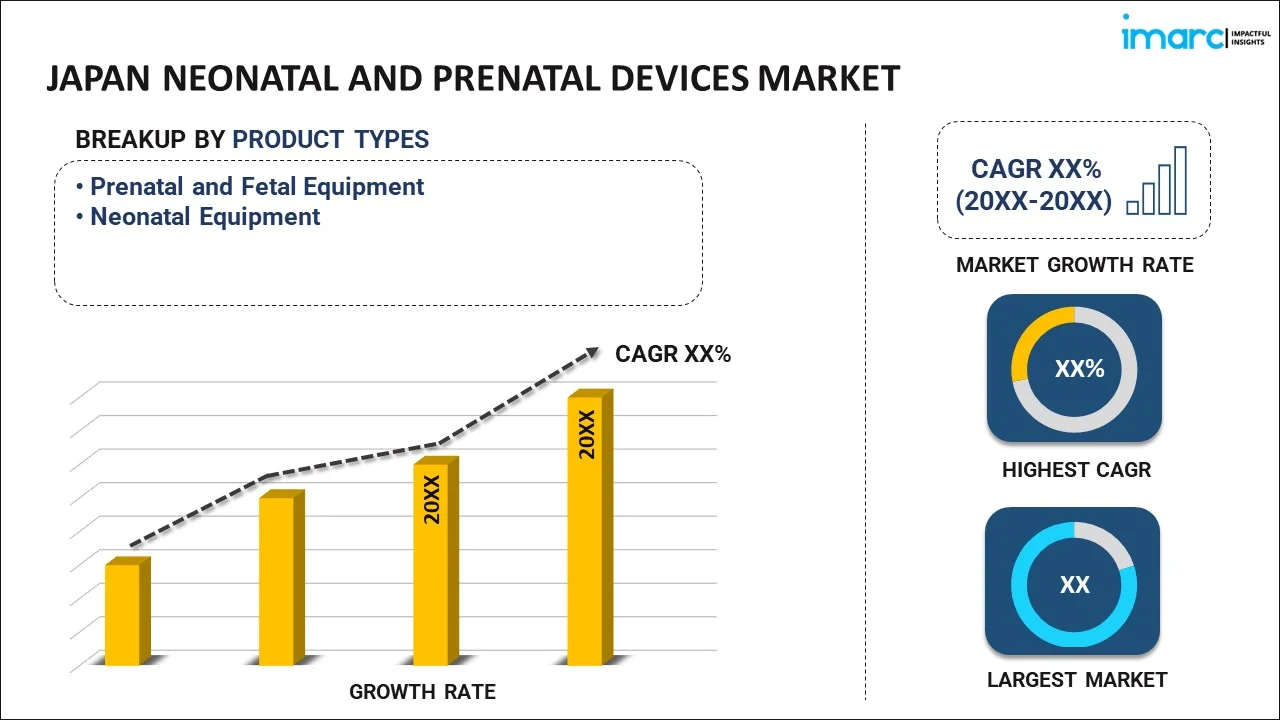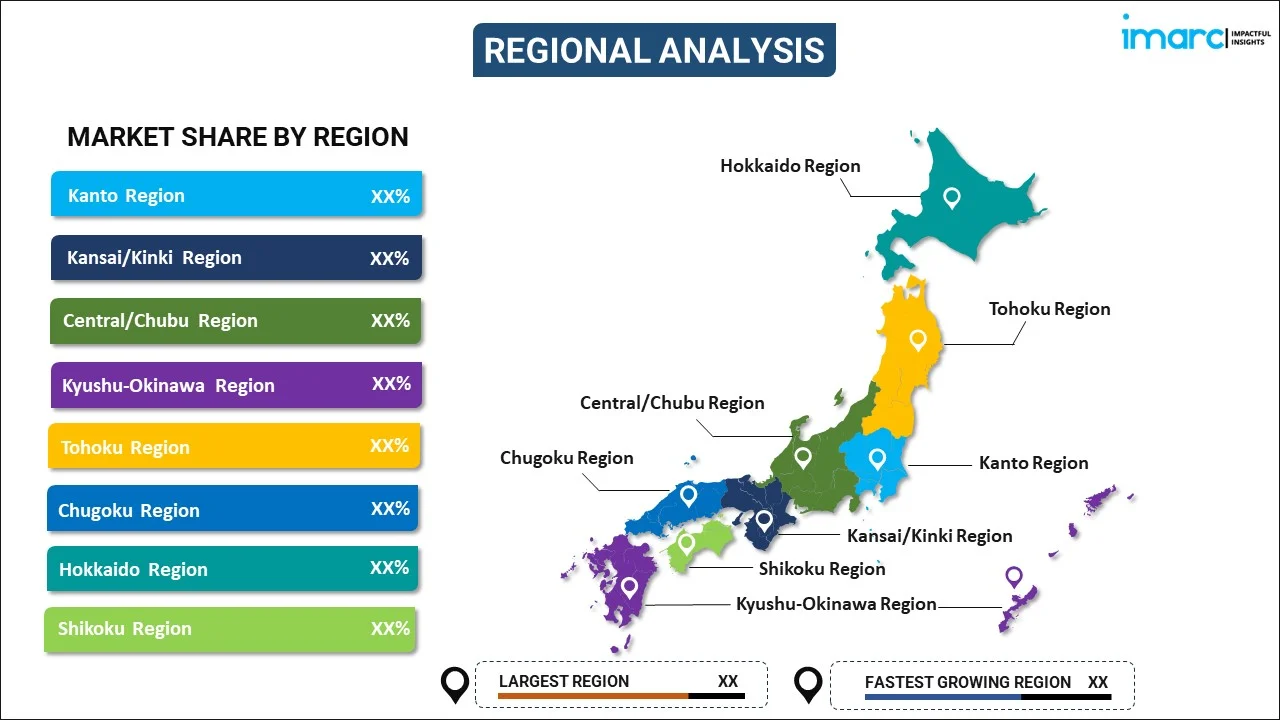
Japan Neonatal and Prenatal Devices Market Report by Product Type (Prenatal and Fetal Equipment, Neonatal Equipment), and Region 2025-2033
Market Overview:
Japan neonatal and prenatal devices market size reached USD 462.0 Million in 2024. Looking forward, IMARC Group expects the market to reach USD 857.0 Million by 2033, exhibiting a growth rate (CAGR) of 7.1% during 2025-2033. The escalating demand for high-resolution ultrasound machines and fetal monitors with advanced diagnostic capabilities, and state-of-the-art neonatal incubators and ventilators is primarily augmenting the market growth.
|
Report Attribute
|
Key Statistics
|
|---|---|
|
Base Year
|
2024
|
|
Forecast Years
|
2025-2033
|
|
Historical Years
|
2019-2024
|
|
Market Size in 2024
|
USD 462.0 Million |
|
Market Forecast in 2033
|
USD 857.0 Million |
| Market Growth Rate 2025-2033 | 7.1% |
Neonatal and prenatal devices represent a critically important branch of medical technology focused on the care and monitoring of both unborn infants and newborns. These specialized devices and equipment are designed to ensure the health and well-being of fetuses during pregnancy and provide essential support to newborns in the critical early stages of life. Prenatal devices include ultrasound machines, fetal monitors, and specialized diagnostic tools that enable healthcare professionals to track the progress of pregnancy and address any emerging issues promptly. Neonatal devices, on the other hand, are geared towards the unique needs of newborns, particularly those born prematurely or with medical conditions requiring intensive care. These devices encompass a wide range of equipment such as incubators, ventilators, phototherapy units, and monitoring systems. They are instrumental in providing a controlled environment, assisting with breathing, and ensuring the stability and development of neonates during their crucial initial stages of life. The field of neonatal and prenatal devices plays a pivotal role in reducing infant mortality rates and improving the overall quality of maternal and neonatal healthcare.
Japan Neonatal and Prenatal Devices Market Trends:
The neonatal and prenatal devices market in Japan is characterized by a commitment to advanced healthcare technologies, a strong emphasis on infant and maternal well-being, and a rapidly aging population. Japan is renowned for its advanced medical technology, and this extends to neonatal and prenatal devices. The market features cutting-edge equipment such as high-resolution ultrasound machines, fetal monitors with advanced diagnostic capabilities, and state-of-the-art neonatal incubators and ventilators. Additionally, innovations, such as telemedicine, remote monitoring, and data analytics, are enhancing the efficiency and effectiveness of care delivery, particularly in remote or underserved areas, which is acting as another significant growth-inducing factor. Preterm births continue to be a concern in Japan, leading to a focus on devices and interventions to improve the survival rates and long-term outcomes of premature infants. This includes specialized neonatal intensive care units (NICUs) equipped with advanced devices. Moreover, tailored treatment plans and diagnostics are projected to fuel the market growth in the coming years.
Japan Neonatal and Prenatal Devices Market Segmentation:
IMARC Group provides an analysis of the key trends in each segment of the market, along with forecasts at the country level for 2025-2033. Our report has categorized the market based on product type.
Product Type Insights:

- Prenatal and Fetal Equipment
- Ultrasound and Ultrasonography Devices
- Fetal Magnetic Resonance Imaging (MRI)
- Fetal Heart Monitors
- Others
- Neonatal Equipment
- Incubators
- Neonatal Monitoring Devices
- Respiratory Assistance and Monitoring Devices
- Others
The report has provided a detailed breakup and analysis of the market based on the product type. This includes prenatal and fetal equipment (ultrasound and ultrasonography devices, fetal magnetic resonance imaging (MRI), fetal heart monitors, and others) and neonatal equipment (incubators, neonatal monitoring devices, respiratory assistance and monitoring devices, and others).
Regional Insights:

- Kanto Region
- Kansai/Kinki Region
- Central/ Chubu Region
- Kyushu-Okinawa Region
- Tohoku Region
- Chugoku Region
- Hokkaido Region
- Shikoku Region
The report has also provided a comprehensive analysis of all the major regional markets, which include Kanto Region, Kansai/Kinki Region, Central/ Chubu Region, Kyushu-Okinawa Region, Tohoku Region, Chugoku Region, Hokkaido Region, and Shikoku Region.
Competitive Landscape:
The market research report has also provided a comprehensive analysis of the competitive landscape in the market. Competitive analysis such as market structure, key player positioning, top winning strategies, competitive dashboard, and company evaluation quadrant has been covered in the report. Also, detailed profiles of all major companies have been provided. Some of the key players include:
- APEL Co. Ltd.
- Atom Medical Corporation
- GE HealthCare Technologies Inc.
(Please note that this is only a partial list of the key players, and the complete list is provided in the report.)
Japan Neonatal and Prenatal Devices Market Report Coverage:
| Report Features | Details |
|---|---|
| Base Year of the Analysis | 2024 |
| Historical Period | 2019-2024 |
| Forecast Period | 2025-2033 |
| Units | Million USD |
| Scope of the Report | Exploration of Historical and Forecast Trends, Industry Catalysts and Challenges, Segment-Wise Historical and Predictive Market Assessment:
|
| Product Types Covered |
|
| Regions Covered | Kanto Region, Kansai/Kinki Region, Central/ Chubu Region, Kyushu-Okinawa Region, Tohoku Region, Chugoku Region, Hokkaido Region, Shikoku Region |
| Companies Covered | APEL Co. Ltd., Atom Medical Corporation, GE HealthCare Technologies Inc., etc. |
| Customization Scope | 10% Free Customization |
| Post-Sale Analyst Support | 10-12 Weeks |
| Delivery Format | PDF and Excel through Email (We can also provide the editable version of the report in PPT/Word format on special request) |
Key Questions Answered in This Report:
- How has the Japan neonatal and prenatal devices market performed so far and how will it perform in the coming years?
- What has been the impact of COVID-19 on the Japan neonatal and prenatal devices market?
- What is the breakup of the Japan neonatal and prenatal devices market on the basis of product type?
- What are the various stages in the value chain of the Japan neonatal and prenatal devices market?
- What are the key driving factors and challenges in the Japan neonatal and prenatal devices?
- What is the structure of the Japan neonatal and prenatal devices market and who are the key players?
- What is the degree of competition in the Japan neonatal and prenatal devices market?
Key Benefits for Stakeholders:
- IMARC’s industry report offers a comprehensive quantitative analysis of various market segments, historical and current market trends, market forecasts, and dynamics of the Japan neonatal and prenatal devices market from 2019-2033.
- The research report provides the latest information on the market drivers, challenges, and opportunities in the Japan neonatal and prenatal devices market.
- Porter's five forces analysis assist stakeholders in assessing the impact of new entrants, competitive rivalry, supplier power, buyer power, and the threat of substitution. It helps stakeholders to analyze the level of competition within the Japan neonatal and prenatal devices industry and its attractiveness.
- Competitive landscape allows stakeholders to understand their competitive environment and provides an insight into the current positions of key players in the market.
Need more help?
- Speak to our experienced analysts for insights on the current market scenarios.
- Include additional segments and countries to customize the report as per your requirement.
- Gain an unparalleled competitive advantage in your domain by understanding how to utilize the report and positively impacting your operations and revenue.
- For further assistance, please connect with our analysts.
 Inquire Before Buying
Inquire Before Buying
 Speak to an Analyst
Speak to an Analyst
 Request Brochure
Request Brochure
 Request Customization
Request Customization




.webp)




.webp)












